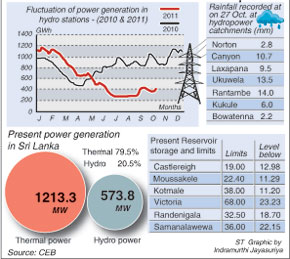| Yet again this year, Sri Lanka experienced less rainfall in the hydro- catchment areas during the South-West (SW) monsoon (May-September) similar to the rainfall in 2008 and 2006, reports G.B. Samarasinghe, Director General (DG) Meteorological Department,.
“In the last five years, the rainfall experienced during the SW monsoon has been the standard average. Annually, 30% range of the average rainfall is expected during the SW monsoon. Since this did not fall within the hydro-catchment areas, power cuts in the foreseeable future will be a real possibility due to this shortfall, although power cuts have not been officially announced by the CEB,” Mr. Samarasinghe said.
Inter-monsoonal showers, at the end of the SW monsoon, will be experienced in October and November and there has been significant rainfall in some of the hydro-catchment areas during the past two days and more rain is expected, he said.
Commenting on the reasons for the lack of rainfall during the SW monsoon, - Met Dept., DG said that the main reason is the global climate change and the inactive monsoonal period which reacts most of the time according to the natural weather setup, and hence, the SW monsoon was not active as expected.
“Man-made reasons are one of the main causes to upset climate stability, along with changes due to natural interference”, he said.
In April, the Met. Dept forecast that the rainfall would be 10% above average for the duration of the SW monsoon, considering the worldwide meteorological output.
However, less than 50% of the average rainfall was received during the SW monsoon. Usually, the SW monsoon sets in around the third week in May, but this year the onset of the monsoon was towards the end of May.
Accordingly, 30%of the average rainfall is forecast for the SW and NE monsoons, and 40%of the average is forecast during the inter-monsoonal showers.
The Met. Department reported that the SW monsoon in 2010 was favourable as forecast, for the hydro-catchment areas, while this year it was comparatively less than what was forecast.
Of the past five years, 2006, 2008 and this year recorded below average rainfall, while 2010 had the best, with 2009 and 2007 experiencing average rainfall during the SW monsoon.
Accordingly, most of the hydropower reservoirs received less rainfall in 2011, 2008 and 2006, while 2010 was a favourable year. |


